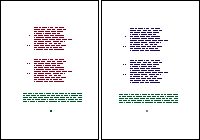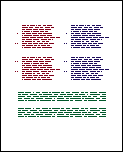
NEXT
BY WAY OF INTRODUCTION
What is here contained does not pretend to be a work of scholarship. A word of explanation may therefore be appropriate.
Like many people on first meeting with Middle English, I suppose, I formed a too hasty opinion. Being something of a perfectionist myself in matters of syntax and spelling I assumed too readily that the all-too-common departures from rectitude which I saw in the work of these early writers were signs of lack of skill in the handling of the language and particularly the language of verse. In this respect I fell into the same trap as the humanists of a later generation, who turned from the apparent crudities and uncertainties of this early language to Latin, in the mistaken belief that the gravity of another culture was preferable to the na´vetÚ which they took for barbarism. They would doubtless have had no small difficulty in believing that the time would come when a grammarian would recommend writers in English to prefer the Saxon word to the Romance', that the English language which they regarded with some evident distaste would prove to be the lingua franca of the entire world, and that an Englishman might then find it difficult to learn a foreign tongue because of the eagerness of the foreigner to learn and practice his.
I became intrigued with the work of an unknown poet who created the poem 'Pearl' during my degree course as a very mature student (at least in years) at York University, where the work formed one of the set pieces in the Middle English paper. When the need came to decide on a subject for the 'long essay' which was an examination requirement I suggested on an impulse that I would like to take a shot at translating the poem into a more modern, and for the newcomer to Middle English, a more readily available language, perhaps.
It is a common belief that some writers are very odd people, and few people less prone to eccentricity than your average academic; my suggestion did not, I gather, meet with universal enthusiasm among the tutorial staff. But in the end - perhaps as a concession to advancing years - a compromise was reached, thanks largely to the support given to the suggestion by two women tutors and by the splendid Head of Department in Professor Javques Berthoud. It was decided that I was to translate only half the poem and add a short essay outlining the approach and the problems encountered.
The compromise proved helpful, since I was to discover that the work of translating even one half of the poem took up most of the long vacation. However, that was a small price to pay for an experience which was at times exhausting but always exhilarating. The outcome was that before the degree course ended I had completed the translation of the entire poem. I ought to add at this point that the somewhat eccentric system of page numbering which I have adopted is quite deliberate * , in that my intention was to allow the reader to see, without the need to turn the page, the original verse, a prose translation, and my own version in a more modern language. (The word 'modern' demands some modification; there were many times when the occasional archaism was forced upon me to remain faithful to the rhyme-scheme).
My hope now is that later students will be helped by this amateur effort (in the true sense of the word 'amateur') to acquaint themselves with a poem which has endured, as all great literature endures, and for some good reason. As Aldous Huxley wisely said, some writing is deservedly forgotten; none is undeservedly remembered.
The first effort at translation will always be for me a reminder that women are sometimes more liberal in their judgement than men. It is largely to a woman tutor Philippa Tristram, that I owe the experience of at least being given a chance to attempt the translation of a great English poem. This is a suitable moment to thank her for her support; if your experience of the poem is, even in small measure, comparable to my own, then you too will owe her your thanks.
I have not the slightest doubt that the translation will meet with no rapturous reception in a lover of verse; I can only suggest that before you condemn it out of hand it might be a good idea to take a stanza or two and make the effort to repeat what I tried to do. I have little doubt that you will be as impressed as I was by the intricacy of the poem's metrical and rhyming structure; you may also begin to agree with the cynic who said that "Translations are like women; if they're beautiful they're probably not faithful, and if faithful probably not beautiful.' For myself I can only testify to my own experience in that, while this may be true of translation, there are certainly women who are both beautiful and faithful; it is to the patience and longsufferring of one such in my own wife, Dorothy, that I am indebted for putting up with my occasional savagery when the long hours of wrestling with 'Pearl' were proving for a time rather hard for both of us to take.
I repeat, to judge this effort as a piece of scholarship would be to credit me with a presumption which I never adopted for a single moment. The idea is to enjoy the poem; if it spurs you on to write a better translation I shall be the first to applaud.
Bill Stanton
Langwith College
*
Ed. PLEASE NOTE.
 Layout in the original manuscript
Layout on this website. COLOUR CODEOriginal Verse Modern Translation Literal Translation
|
